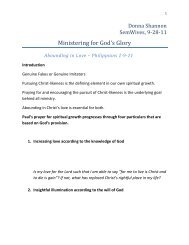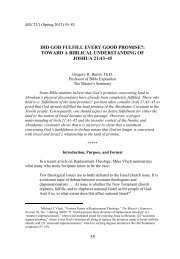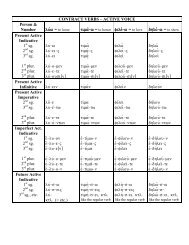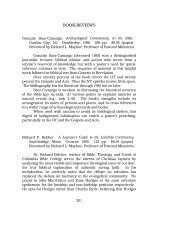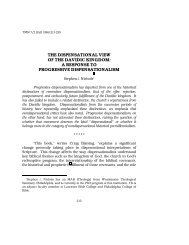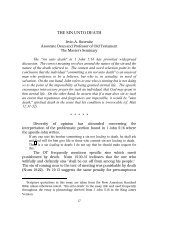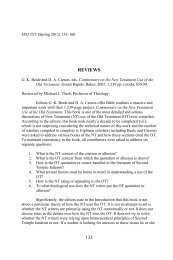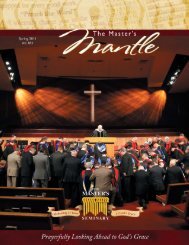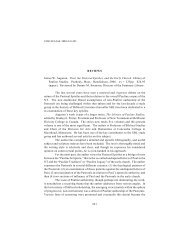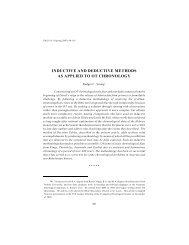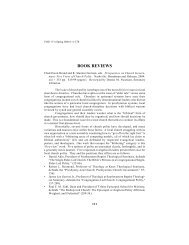dynamic equivalence: a method of translation or a system
dynamic equivalence: a method of translation or a system
dynamic equivalence: a method of translation or a system
- No tags were found...
You also want an ePaper? Increase the reach of your titles
YUMPU automatically turns print PDFs into web optimized ePapers that Google loves.
166 The Master's Seminary Journallanguages into a special categ<strong>or</strong>y because <strong>of</strong> it, 94 unless they themselves hold alower view <strong>of</strong> biblical inspiration? How, then, can these same auth<strong>or</strong>ities in acontext <strong>of</strong> discussing Bible <strong>translation</strong> insist that anything said in one language canbe said in another, 95 when there is inevitably some loss <strong>of</strong> meaning in translatingfrom the inspired <strong>or</strong>iginal into other languages? Is there an evangelical rationalef<strong>or</strong> such emphases?While opposition by D-E to an evangelical view <strong>of</strong> inspiration may not beviewed as explicit, there are implications and overtones that raise seriousquestions. Certainly no doubt can be entertained about the clear evangelical stance<strong>of</strong> some individuals that have participated in D-E eff<strong>or</strong>ts. The question here relatesto the foundational philoso-phy behind D-E.The same type <strong>of</strong> questions exists in regard to the hermeneutical emphases<strong>of</strong> contextualization. F<strong>or</strong> example, the position <strong>of</strong> Charles Kraft regarding therelative nature <strong>of</strong> all <strong>system</strong>atic theology 96 calls into question the traditionaldoctrine <strong>of</strong> inspiration with its associated grammatico-hist<strong>or</strong>ical <strong>method</strong> <strong>of</strong>interpretation. 97 Herein lies another similarity <strong>of</strong> D-E to contemp<strong>or</strong>aryhermeneutics.The two fields can be tied together even m<strong>or</strong>e specifically when, now andthen, some <strong>of</strong> the hermeneutical presuppositions <strong>of</strong> D-E come to light. F<strong>or</strong>example, Nida and Reyburn appear to be in agreement with Smalley regarding thenon-absolute nature <strong>of</strong> biblical revelation. Smalley elab<strong>or</strong>ates on alleged biblicaldiversity in such a way as to raise questions about his view <strong>of</strong> inspiration. Henotes that Jesus in the antitheses <strong>of</strong> Matt 5 revoked the teachings <strong>of</strong> Moses in theOT and substituted a new standard that was better suited to the Palestinian culture<strong>of</strong> the first century. 98 Nida and Reyburn accept this proposition that differingcultures have caused contradict<strong>or</strong>y presuppositions in the Bible, citing the samepassage as Smalley to prove their assertion. 99 Other contradictions that they citeinclude the teaching <strong>of</strong> henotheism in certain parts <strong>of</strong> the OT and the teaching <strong>of</strong>monotheism in others, the OT teaching <strong>of</strong> polygamy as set aside in the NT, and theNT rejection <strong>of</strong> the OT sacrificial <strong>system</strong>. 100If this is not an explicit disavowal <strong>of</strong> an evangelical view <strong>of</strong> inspiration, it isat best a foggy representation.94Ibid., 3, 6. In discussing D-E, Kraft rejects "mere literalness even out <strong>of</strong> reverence f<strong>or</strong> supposedlysacred w<strong>or</strong>ds [italics added]" (Kraft, "Dynamic Equivalence" 44). Is this an implicit denial that thew<strong>or</strong>ds <strong>of</strong> the <strong>or</strong>iginal text were inspired?95Ibid., 4.96Kraft, Christianity in Culture 291-292.97Article XVIII, "Articles <strong>of</strong> Affirmation and Denials, The Chicago Statement on BiblicalInerrancy," International Council on Biblical Inerrancy (Chicago, 1978); Article XV, "Articles <strong>of</strong>Affirmation and Denials, The Chicago Statement on Biblical Hermeneutics," International Councilon Biblical Inerrancy (Chicago, 1982).98W. A. Smalley, "Culture and Superculture," Practical Anthropology 2 (1955) 60-62; Kraft,Christianity in Culture 126. Evangelical attempts to cope with alleged biblical diversity are usually alittle m<strong>or</strong>e subtle than Smalley's; see Scholer, "Issues" 14-18, and I. H. Marshall, "An EvangelicalApproach to `Theological Criticism,'" Themelios 13/3 (Apr/May 1988) 79-85.99Nida and Reyburn, Meaning 26-27.100Ibid.



